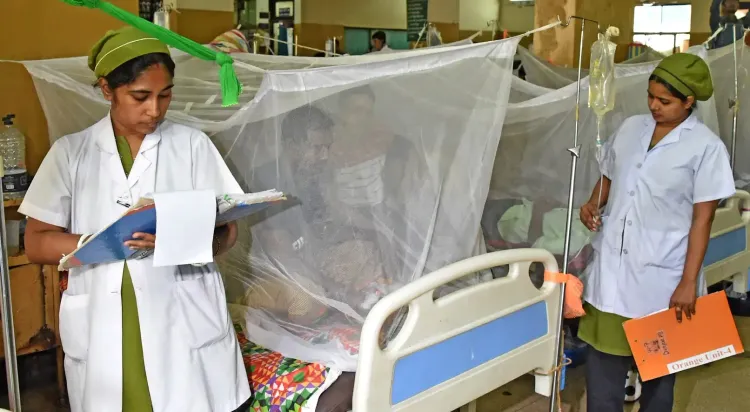Is the dengue situation in Bangladesh worsening?

Synopsis
Key Takeaways
- Dengue cases and deaths are rising sharply in Bangladesh.
- Five new fatalities reported in just 24 hours.
- Importance of early detection and treatment highlighted.
- Vector control is essential for prevention.
- Public awareness and personal responsibility are critical.
Dhaka, Nov 6 (NationPress) The dengue crisis in Bangladesh is escalating alarmingly, with both infections and fatalities surging across the nation.
In just 24 hours leading up to Thursday morning, five additional individuals succumbed to dengue, escalating the total death toll from this mosquito-borne illness in Bangladesh for 2025 to 307, as reported by local media.
Among the most recent fatalities, three occurred in the Dhaka South City Corporation (DSCC), while one was reported in both the Dhaka North City Corporation (DNCC) and Mymensingh Division, according to the Directorate General of Health Services (DGHS).
During this same timeframe, there were 1,034 new hospital admissions for viral fever, raising the cumulative number of cases in 2025 to 76,026, as reported by United News of Bangladesh.
Currently, 1,155 patients are being treated in Dhaka, while 3,331 others are receiving care in various hospitals throughout Bangladesh.
The report indicates that among the patients this year, 62.3% are men and 37.7% are women.
In terms of fatalities, 52.8% were male and 47.2% were female.
Last year, 575 people lost their lives due to dengue. During that same period, the DGHS documented 101,214 dengue cases and 100,040 recoveries.
On October 9, DGHS Director General Abu Jafor remarked that while the number of dengue cases in 2025 has surpassed that of the previous year, the mortality rate is lower.
During a press briefing regarding the ‘Typhoid Vaccination Campaign-2025’ at the Health Ministry, Abu Jafor stated, “This year, the incidence of dengue infections exceeds that of last year, but the mortality rate in relation to infections is lower,” as reported by United News of Bangladesh.
He emphasized the importance of controlling mosquito breeding and eliminating their larvae to mitigate dengue. “It is crucial that individuals employ mosquito nets and take protective measures. These responsibilities primarily lie with each person. Neglecting these duties will make it exceedingly difficult to eradicate dengue,” he cautioned.
He added, “Our data indicates that over half of dengue-related deaths occur on the very first day of hospital admission. This highlights that patients are not seeking care promptly. We are committed to ensuring effective management within hospitals.”
Abu Jafor underscored the necessity of early diagnosis, stating that if dengue is identified early, it can be managed at home with appropriate medical attention. He attributed the rising death rate from dengue to a lack of awareness, negligence, and delays in seeking medical treatment.
Dengue is a viral infection caused by the dengue virus (DENV), which is transmitted to humans through bites from infected mosquitoes. It is prevalent in tropical and subtropical regions globally, particularly in urban and semi-urban areas, according to the World Health Organisation (WHO). The prevention and control of dengue rely heavily on vector management. Although there is no specific cure for dengue, early detection and access to appropriate medical care can significantly reduce fatalities associated with severe dengue.









